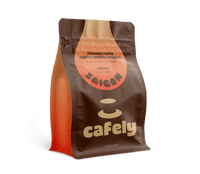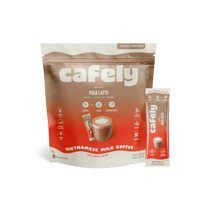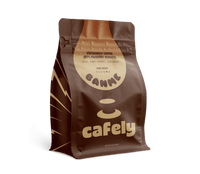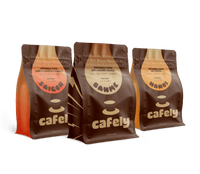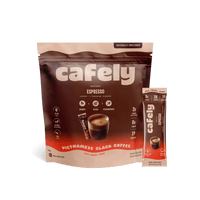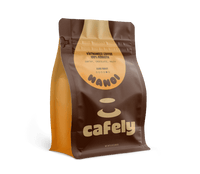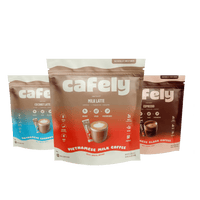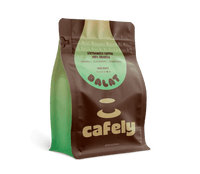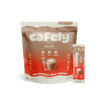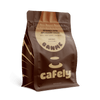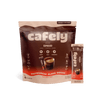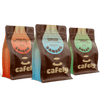Single-origin coffee highlights the flavors of a particular region. Rather than being made from a blend of beans from across the globe, single-origin coffee is region-specific.
Most agree that single-origin coffee is superior to multi-origin coffee, but why?
In this article, we delve into what makes a coffee “single-origin,” the different types of single-origin coffee, and why it may make a better brew…
>> Shop Single Origin Coffees At Cafely
What is Single Origin Coffee?

Single-origin coffee is harvested from a particular geographical region. It can come from one estate, region, or even a single acre within a farm. It can also come from a variety of plantations within a regional cooperative.
The idea behind single-origin coffee is to celebrate the characteristics of coffee plants within a single environment. The regional strain of coffee used, the environmental conditions it's grown in, and the soil in the area all affect the taste of the resulting brew. The history of coffee and the region's traditional cultivation methods and practices also contribute to the overall flavor profile.
Multi-origin coffee — beans sourced from around the world and blended — won't highlight the flavors from a specific region, whereas single-origin will.
Single Origin vs. Single Estate vs. Fair Trade
Several different terms are used to describe the source and production of coffee. It can be confusing to understand the difference between these terms.
Single-origin can be used as a broad term that covers several different sub-categories. For instance, “single estate coffee” is single-origin, but it comes from one plantation rather than a cooperative of farmers within a region.
Here are the different terms often used to describe the origin and production of coffee beans:
1. Single Origin Coffee
Single-origin is a broad term used to describe coffee from one particular geographical region. Single-origin coffee could be from an area of just 50 square miles or from one country.
If a brand uses the term “single-origin” to describe the source of its coffee, it usually means it's from a large area within a geographical region.
2. Single Estate Coffee
Single-estate coffee is sourced from one coffee plantation within a region. It can come from large farms in South America, Africa, or Asia.
Single-estate coffee generally has a more distinctive flavor profile and higher quality compared to multi-origin or single-origin coffee sourced from several different farms within a region. Consequently, single-estate coffee is more expensive.
3. Single Cooperative Coffee
In countries such as Africa, Jamaica, and Cuba, where coffee production isn't as high, single-cooperative coffee is more common. Some farmers may only produce one or two bags of coffee per year. These farmers often enter cooperatives where a selection of small farms within an area combine their harvests.
The local cooperative may process their coffee together, combining the coffee from several smaller farms within a region. Many coffee cooperatives have strict harvesting, storage, and transport requirements, ensuring that all the beans used are of the highest quality.
A good cooperative coffee from regions such as Ethiopia and Tanzania fetch high prices. Coffees made through cooperatives are usually artisanal, combining rarer varieties of arabica beans or robusta coffee to create unique blends that celebrate the flavors of the region.
4. Fairtrade Coffee
Fairtrade coffee isn't strictly single-origin. If you see a bag of coffee stamped with the Fairtrade logo, don't assume the beans all come from the same region.
Fairtrade coffee simply means that the coffee has been certified by Fairtrade International. It ensures that every worker during the production process is paid fairly, works in safe conditions, and uses sustainable farming practices.
It's possible to find Fairtrade single-origin coffee, but several brands will source and blend beans from Fairtrade farms across the globe.
5. Macrolot Coffee
Macrolot coffee is similar to cooperative coffee. Macrolot coffee can come from a single farm or a community of farmers from a region.
This type of single-origin coffee will contain a specific strain of Coffea from one species (arabica, robusta, liberica, etc). Although the coffee may not come from one farm, a macrolot generally covers a small geographical region, ensuring all the coffee collected and processed produces the same flavor profile.
Macrolot coffee can change from year to year, depending on the availability of a certain type of coffee and the environmental conditions of the season. For example, “the same” macrolot coffee from Uganda can taste completely different from 2023 compared to 2024.
6. Microlot Coffee
Microlot coffee is sourced from a single lot of a larger farm or estate. The highest-quality beans are selected from plants with unique characteristics. These “microlots” are developed for their high-quality and unique flavor characteristics.
Microlot coffee is considered the “best” type of single-origin coffee because it often comes from a single piece of land within an area less than 10 kilometers squared.
Although some farms may mass produce multi-origin coffee or broader single-origin, their microlots will be harvested and processed separately from the rest of the crop. This ensures that every bean within a bag is from the same small area and exhibits identical flavor and aromatic traits.
Is Single Origin Better Than Multi-Origin Coffee?

Most people agree that single-origin is better, but that may not be the case. Both single-origin and multi-origin coffee have their perks.
Here’s the perks of both types:
Single Origin Coffee
Single-origin coffee is generally considered better than multi-origin coffee because it produces a brew with consistent, unique, and original flavor profiles. If you're looking for quality and a cup of Joe that truly celebrates the coffee of a particular region, single-origin is the way to go.
With that said, single-origin coffee is not without its flaws. It's usually more expensive, and certain types have limited availability — if you find a bag you thoroughly enjoy, you may not be able to get it again in the future.
The flavor of single-origin coffee is also inconsistent from year to year. For example, if the growing season was particularly poor in Colombia for one year, single-origin coffee from the region may be inferior.
Multi Origin Coffee
Multi-origin coffee, although not considered "as good" as single-origin coffee, has a few perks. Blending beans from a variety of regions creates a consistent flavor profile year in and year out. They are cheaper and more accessible than single-origin beans, meaning once you find a bag you like, you'll be able to buy it time and time again.
With that said, multi-origin blends don't have the same depth of flavor and unique profiles as single-origin blends. It's also much harder to trace the origin of the beans used.
Whether single or multi-origin coffee is better ultimately comes down to what you expect from a cup of coffee. If you want to explore the world with the flavors of coffee from different regions, opt for single-origin. If you're looking for a consistent coffee for your everyday morning cup of Joe, opt for multi-origin coffee.
FAQs: Single Origin Coffee
Want to learn more about single and multi-origin coffee?
Read the answers to the FAQs below to learn more…
1. Is Single Origin Coffee the Same as Single Estate Coffee?
Although single-origin coffee and estate coffee can come from a “single-origin,” they are slightly different.
Single-origin coffee often comes from a cooperative of plantations in a single region. On the other hand, estate coffee comes from a single estate or farm.
2. Can You Get Robusta and Arabica Single Origin Blends?

Yes. You'll find single-origin coffee made from arabica, robusta, and a blend of both. Single-origin coffee is available from various regions around the globe, many of which grow both species.
3. Why Is Single-Origin Coffee More Expensive?
Single-origin coffee is generally more expensive because it comes from smaller-scale productions. The blends are usually of higher quality and come from a plantation in a unique region.
4. What Are the Differences Between Arabica and Robusta Single-Origin Coffee?
Single-origin coffee can be arabica, robusta, or a blend of both. These two types of coffee are different species, and each exhibits unique characteristics. Arabica beans produce sweet, smooth brews, and robusta beans produce strong, dark, slightly bitter brews.
5. What Are the Best Regions for Single-Origin Coffee?
Most people agree that the best single-origin coffee comes from East Africa — the birthplace of coffee. Countries such as Ethiopia, Tanzania, and Kenya are famed for high-quality single-origin arabica coffee. These countries produce complex beans that produce earthy, citrus, and floral notes. Vietnam is famed for single-origin robusta coffee with dark, chocolatey, nutty notes.
6. How Can I Identify the Origin of My Coffee?
It's not a legal requirement for a brand to supply information on the specific origin of its coffee. Some brands will provide information on the region and even specific forms either on the coffee packaging or on the website. Other brands won't provide any information. If you're interested in the origin of your coffee, opt for a brand that's transparent about its sourcing and processing. Most trusted brands provide behind-the-scenes information on how coffee is made from plant to coffee grounds to give their customers a better understanding of what they're brewing and sipping.
7. What Is the Difference Between Fair Trade and Single-Origin Coffee?
Single-origin means the coffee has been produced in a select region, whereas fair trade simply means the coffee has been certified by Fair Trade International, ensuring ethical and fair working conditions for everyone involved with coffee production. Coffee can be both fair trade and single-origin.
8. How Should Single-Origin Coffee Be Stored?
Single-origin coffee should be stored in the same way as “regular coffee.” It must be stored in an airtight container away from light, heat, and moisture. Storing single-origin coffee properly will preserve its depth of flavor.
9. What Are the Health Benefits of Single-Origin Coffee?
There are no particular health benefits that are unique to single-origin coffee. However, single-origin coffee is generally of higher quality than multi-origin. It may have higher antioxidant levels, which could benefit health by reducing oxidative stress in the body.
10. How Do I Find the Best Single-Origin Coffee for My Taste?
Choosing the right single-origin coffee for your palate is down to you. If you prefer smoother, milder coffee, you may want to opt for arabica. If you like a strong dark coffee, you may prefer robusta. If you're somewhere in the middle, you may prefer a robusta and arabica blend.
To find the right coffee for you, take our quiz on finding the perfect cup.
